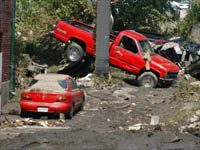In the fall of 2010, the gulf coast of the United States is again struck by a category four hurricane. Five years of planning and preparation swing into action. Hospitals, structurally reinforced to survive such storms, remain open and operational, serving their communities during and after the storm. State and Federal recovery plans assist displaced people return to home and even find jobs. The criticisms of Katrina resulted in palpable change!
As life returns to normal, people begin to shift their healthcare needs from the hospitals back to the community. To the horror of those who have moved back home, they find that many of their doctors have not returned. Not only are the medical professionals missing, but the all important ancillary providers are absent. In many communities, only one dentist or chiropractor is able to return and restart their practices. Healthcare services become the next disaster to spread across the region.
Where Did All the Doctors Go?
While most hospitals in the United States are corporately owned and supported, most healthcare providers are owners or employees of small, local businesses. Even the biggest medical practices in a community are regionally limited in presence, thus when a community is temporarily displaced by disaster, the most secure healthcare providers find themselves displaced as well.
Few small businesses have the financial reserves to meet fixed costs of business during a forced shutdown. The problem for healthcare practices is complicated by the costs associated with malpractice insurance, general liability insurance, employee benefits, healthcare student loans, equipment leases, licensure and more. In most cases, healthcare practices maintain less than two weeks funds for fixed expenses in reserve. Although the delay in payment inherent to insurance billing and other third party payment systems can help bridge the period of shutdown, the shutdown will eventually manifest as a gap in cash flow.
Faced with the probability of financial ruin, many healthcare providers seek new practice opportunities after only a short period of displacement. Once established in a new community, the likelihood of uprooting the family again and moving back to their old home is very small. This was the experience following hurricanes Andrew, Opal, Charlie and Katrina.
What Should Be Done?
The key need for the community is the return of their most trusted and valued professionals. These professionals have a key need as well; they need to reestablish their practice as soon as possible. The most obvious solution is to include these healthcare professionals in the disaster response and recovery plan. One significant lesson observed during hurricane Katrina is that if a healthcare provider is not part of the response plan before the disaster, there will be no role for them during the response and recovery.
How do healthcare providers become part of their local disaster plan?
The opportunities to participate in a disaster response exist in a matrix based on the intersections of four options:
- Paid vs. Volunteer
- Hospital vs. Office/Clinic
The matrix is:
| Paid at Hospital | Volunteer at Hospital |
| Paid at Office/Clinic | Volunteer at Office/Clinic |
The healthcare provider seeking to survive as a business may initially serve a volunteer role, but they must eventually transition to a paid, fee for service role and reestablish their profitable business operations.
From Free to Fee
How does a healthcare provider make the transition from a volunteer to a paid provider?
Here are some suggestions:
- The healthcare professional must state how long they can offer their services for free. Healthcare providers in various jurisdictions are constrained as to the type of services that can be offered for free and circumstances in which services can be offered for free, thus it is essential that healthcare providers be explicit regarding the commitments they can make. For example,
“I can afford to volunteer for one week. I can afford to bring X amount of supplies. If we run out of materials before two weeks, you supply the material and I’ll stay the remainder of the time I stated.”
After the two weeks are up, before the healthcare provider pulls out and leaves, the provider should talk with the people they have been helping. At this point, the community can ask the provider to stay and begin providing services for a fee.
- When the community writes the disaster response and recovery plans (before a disaster hits), the healthcare providers should register with the ESF-8 (Emergency Support Function 8) office of their local and state Emergency Operations Center. This office is responsible for ensuring that critical services, including healthcare, are included in disaster planning. Further, during a disaster response and recovery, the ESF-8 office is responsible for ensuring that the critical service provider receives supplies and resources to remain operational.
- Become a community resource as a healthcare service provider and receive referrals for fee based services. This is completely ethical. In fact, it’s a win-win solution. The community keeps its healthcare professionals and the healthcare provider has work. What could be better?
The bottom line is that healthcare businesses need to understand the different ways to participate in a disaster response, and they need to get over the stigma of profiting from disaster. Realize that the people receiving healthcare services don’t mind paying for them. Similarly, communities and emergency management professionals must expand their plans to include all healthcare professionals in the community, not just the medical physicians, nurses and hospital staff. After all, the healthcare providers in a community were important to the community before the disaster, how much more important are these professionals after the disaster?










